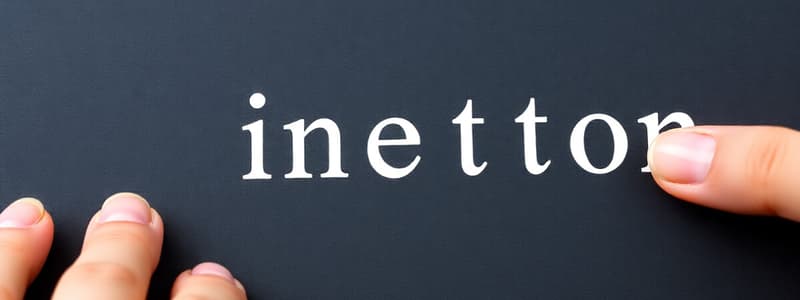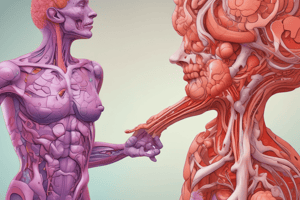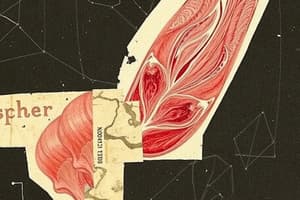Podcast
Questions and Answers
How does compounding typically affect the meaning of the resulting word?
How does compounding typically affect the meaning of the resulting word?
- It forms a new meaning that is related to, but distinct from, the meanings of the original words. (correct)
- It always results in a meaning that is a direct combination of the original words' individual meanings.
- It retains the exact meanings of the original words without change.
- It only affects the pronunciation but not the meaning of the original words.
What is the defining characteristic of words formed through reduplication?
What is the defining characteristic of words formed through reduplication?
- They combine two or more independent words.
- They are derived from the names of people or places.
- They involve repeating all or part of a morpheme. (correct)
- They are created by shortening existing words.
How do eponyms originate?
How do eponyms originate?
- From the names of people or brands associated with the word's referent. (correct)
- Through a process of gradual sound change over time.
- By randomly assigning new names to existing objects or concepts.
- By combining parts of different words to form a new word.
Acronyms like NASA and NIMBY are formed through what process?
Acronyms like NASA and NIMBY are formed through what process?
If a new word is created through a combination of multiple word-formation processes, which of the following is true?
If a new word is created through a combination of multiple word-formation processes, which of the following is true?
Which characteristic is least typical of isolating (analytic) languages?
Which characteristic is least typical of isolating (analytic) languages?
A linguist is studying a language where single affixes often convey tense, mood, and subject agreement simultaneously. Which language type is the linguist most likely investigating?
A linguist is studying a language where single affixes often convey tense, mood, and subject agreement simultaneously. Which language type is the linguist most likely investigating?
In an agglutinating language, how are morphemes typically combined to form words?
In an agglutinating language, how are morphemes typically combined to form words?
Which of the following best describes the practical application of morphological typology in natural language processing (NLP)?
Which of the following best describes the practical application of morphological typology in natural language processing (NLP)?
A linguist discovers a previously unknown language. Initial analysis suggests that words consist of many morphemes, strung together to express complex ideas within a single word. Which language type is it most likely to be?
A linguist discovers a previously unknown language. Initial analysis suggests that words consist of many morphemes, strung together to express complex ideas within a single word. Which language type is it most likely to be?
How does the study of morphological typology contribute to our understanding of language evolution?
How does the study of morphological typology contribute to our understanding of language evolution?
A language learner is struggling to identify the boundaries between morphemes in a new language because the affixes seem to blend together, making it hard to separate individual meanings. Which language type is most likely causing this difficulty?
A language learner is struggling to identify the boundaries between morphemes in a new language because the affixes seem to blend together, making it hard to separate individual meanings. Which language type is most likely causing this difficulty?
Which statement accurately reflects the relationship between morphological typology and linguistic diversity?
Which statement accurately reflects the relationship between morphological typology and linguistic diversity?
Which characteristic is most indicative of polysynthetic languages?
Which characteristic is most indicative of polysynthetic languages?
The Inuktitut word 'tusaatsiarunnanngittualuujunga,' meaning 'I can't hear very well,' exemplifies which type of language?
The Inuktitut word 'tusaatsiarunnanngittualuujunga,' meaning 'I can't hear very well,' exemplifies which type of language?
Which of the following best describes the process of 'borrowing' in linguistics?
Which of the following best describes the process of 'borrowing' in linguistics?
What linguistic process is demonstrated when the German word 'wolkenkrabber' (cloud scraper) is used to represent the English word 'skyscraper'?
What linguistic process is demonstrated when the German word 'wolkenkrabber' (cloud scraper) is used to represent the English word 'skyscraper'?
Which of the following is the most accurate definition of 'neologism'?
Which of the following is the most accurate definition of 'neologism'?
Why was the term 'analog watch' created, and what is this linguistic creation called?
Why was the term 'analog watch' created, and what is this linguistic creation called?
What linguistic process is exemplified by combining 'tooth' and 'brush' to form 'toothbrush'?
What linguistic process is exemplified by combining 'tooth' and 'brush' to form 'toothbrush'?
A company introduces a new product and names it 'Bedazzle'. This is an example of which word formation process?
A company introduces a new product and names it 'Bedazzle'. This is an example of which word formation process?
Which of the following scenarios demonstrates the linguistic process of 'borrowing'?
Which of the following scenarios demonstrates the linguistic process of 'borrowing'?
If a new type of bicycle is invented and people start calling the old bicycles 'traditional bikes', what linguistic process has occurred?
If a new type of bicycle is invented and people start calling the old bicycles 'traditional bikes', what linguistic process has occurred?
Flashcards
Greenhouse
Greenhouse
A structure designed for growing plants, often with controlled climate.
Reduplication
Reduplication
Creating a word by doubling a free morpheme, either fully or partially.
Eponyms
Eponyms
Words derived from the names of people or brands.
Compounding
Compounding
Signup and view all the flashcards
Multiple Processes
Multiple Processes
Signup and view all the flashcards
Polysynthetic Languages
Polysynthetic Languages
Signup and view all the flashcards
Morpheme
Morpheme
Signup and view all the flashcards
Borrowing
Borrowing
Signup and view all the flashcards
Loan Translation
Loan Translation
Signup and view all the flashcards
Neologism
Neologism
Signup and view all the flashcards
Retronym
Retronym
Signup and view all the flashcards
Clipping
Clipping
Signup and view all the flashcards
Blending
Blending
Signup and view all the flashcards
Acronym
Acronym
Signup and view all the flashcards
Morphological Typology
Morphological Typology
Signup and view all the flashcards
Isolating Languages
Isolating Languages
Signup and view all the flashcards
Example of Isolating Language
Example of Isolating Language
Signup and view all the flashcards
Synthetic Languages
Synthetic Languages
Signup and view all the flashcards
Agglutinating Languages
Agglutinating Languages
Signup and view all the flashcards
Example of Agglutinating Language
Example of Agglutinating Language
Signup and view all the flashcards
Fusional Languages
Fusional Languages
Signup and view all the flashcards
Example of Fusional Language
Example of Fusional Language
Signup and view all the flashcards
Study Notes
Word Formation Processes
- Word formation processes are methods used to create new words.
- Understanding these processes helps understand linguistic creativity and grammar.
Outline
- Morphological Typology and Word Formation
- Morphological Processes
- Importance of Morphological Typology and Word Formation
Importance of Morphological Typology and Word Formation
- Linguistic Diversity: Helps linguists understand how languages encode meaning.
- Language Evolution: Provides insights into how languages adapt and evolve.
- Practical Applications: Useful in translation, language teaching, NLP, and linguistic research.
Morphological Typology and Word Formation
- Morphological typology classifies languages based on how they structure and use morphemes.
- This aids linguists in understanding word formation and structure across languages.
- Languages are classified into two main types: Isolating (Analytic) and Synthetic.
Isolating (Analytic) Languages
- Characteristics: Composed of single morphemes.
- Minimal use of affixes.
- Primarily rely on word order and auxiliary words for meaning.
- Example: Mandarin Chinese ("wõ chī fàn" = "I eat rice")
- Practical Implication: Easy to identify due to straightforward structure.
Synthetic Languages
- Use multiple morphemes (bound and free) to form words.
- Often encode grammatical information within a single word.
- Types of Synthetic Languages:
- Agglutinating
- Fusional (Inflectional)
- Polysynthetic.
Agglutinating Languages
- Characteristics: Morphemes combined in a string, each with a single grammatical meaning.
- Morphemes remain unchanged when combined.
- Example: Turkish ("ev-ler-i-nde" = "in their houses")
- Key Feature: Easy to separate and identify each morpheme.
Fusional (Inflectional) Languages
- Morphemes fuse multiple meanings into one affix, making them harder to segment.
- Example: Spanish ("hablo" = "I speak")
- Key Feature: Efficiently encodes information, but less transparent.
Polysynthetic Languages
- Characteristics: Words represent entire sentences by combining multiple morphemes.
- Commonly found in Indigenous languages.
- Example: Inuktitut ("tusaatsiarunnanngittualuujunga" = "I can't hear very well")
- Key Feature: Highly complex words with rich expressiveness.
Morphological Processes (Word Formation)
- Borrowing: Taking words from other languages.
- Special borrowing and English borrowing
- Slang, jargon, dialect, register: Language specific to a group or situation.
- Recent new words: Words recently added to language.
- Coining/Neologism: Newly created words.
- Eponym: Word from a person's name.
- Compounding: Combining two or more words.
- Reduplication: Doubling a word.
- Retronyms: Adding new word to replace older one, or denote new meanings.
- Blending: Combining parts of two words.
- Conversions: Changing the word class.
- Clipping: Shortening a word.
- Acronym/Initialisms: Words formed from initial letters of words.
- Backformation: Removing affixes from a word.
- Multiple processes: Combination of different processes.
- Trade names: Created terms for products (e.g. aspirin, nylon).
Specific Word Formation Examples (Compounding, etc.)
- Compounding: examples like "toothpaste," "peanut butter," "daughter-in-law."
- Nouns + Noun → Compound Noun: "paperclip"
- Noun + Adjective → Compound Adjective: "lifelong," "information-rich"
- Preposition + Noun → Compound Noun: "downfall"
Classifying Word Structures (e.g. space, no space, hyphen)
- No space, space, hyphenated words - examples of different word placement structures.
Acronyms and Initialisms
- Abbreviations formed from initial letters (e.g., SCUBA, LASER).
Websites for Word Formation
- Use websites for studying words and origins (e.g., wordspy.com, www.urbandictionary.com, etymologyonline.com).
Studying That Suits You
Use AI to generate personalized quizzes and flashcards to suit your learning preferences.




